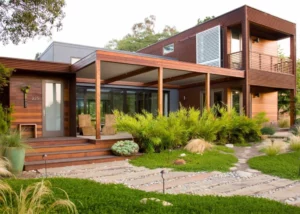Eco-Friendly Home Concepts That Are Easy to Apply
The idea of an eco-friendly home is no longer exclusive to environmentalists or green architecture enthusiasts. Today, in the face of climate change, rising energy costs, and growing awareness of sustainability, many homeowners are beginning to rethink how they live. A sustainable house not only contributes to the health of the planet, but also provides tangible benefits such as energy savings, better indoor air quality, and long-term cost efficiency.
What’s most encouraging is that building or transforming your home into a more environmentally friendly space doesn’t necessarily require a large budget or a complete renovation. In fact, many of the changes you can make are simple, affordable, and can be implemented gradually. The key lies in being intentional with your choices—whether related to materials, energy usage, water management, or daily habits.
Here are several eco-friendly home concepts that are both practical and easy to apply in your everyday life.

1. Embrace Natural Ventilation and Lighting
One of the simplest and most effective ways to make your home more eco-friendly is by optimizing natural ventilation and sunlight. A house that breathes well does not rely heavily on artificial cooling systems like air conditioners or exhaust fans. Cross-ventilation, where air flows smoothly from one side of the house to another, can significantly reduce indoor humidity and improve air quality.
Likewise, maximizing sunlight helps reduce the need for electric lighting during the day. Larger windows, skylights, and light-colored interiors can brighten up your home without flipping a single switch. The combination of fresh air and natural light also brings psychological benefits—improving mood, productivity, and overall comfort.
Designing your home to follow the sun’s path, with windows that allow morning light and protect from harsh afternoon rays, is a simple strategy that adds value over time.
2. Choose Materials That Are Gentle on the Earth
When it comes to building or renovating, the materials you choose matter. Some materials, especially those that are mass-produced and chemically treated, can harm both the environment and your health. Instead, choose materials that are renewable, recyclable, or have a low carbon footprint.
For example, bamboo is fast-growing and sustainable, making it a great alternative to hardwood. Reclaimed wood, recycled bricks, or even compressed earth blocks are all viable, eco-conscious choices. These materials are not only better for the planet but often carry a unique aesthetic appeal as well.
Beyond structural elements, pay attention to finishes and adhesives. Low-VOC (Volatile Organic Compounds) paints and natural sealants help maintain healthier indoor air. With more options available on the market today, choosing safer materials has never been easier or more accessible.
3. Be Smart About Energy Use
Energy efficiency is central to any eco-friendly home. Rather than thinking in extremes—like replacing your entire roof with solar panels—start with smaller, smarter changes.
Replace old, power-hungry bulbs with LED lights, which use up to 80% less energy and last significantly longer. For household appliances, look for energy-efficiency labels and opt for models that use less electricity while maintaining performance.
Beyond devices, your habits play an equally important role. Turn off lights and electronics when not in use, unplug chargers that aren’t needed, and take advantage of timers or smart plugs to reduce energy waste. Over time, these small habits can lead to noticeable savings on your electricity bill and a meaningful reduction in your carbon footprint.
4. Use Water Wisely
Water is often taken for granted, yet it’s one of the world’s most precious resources. A green home manages water efficiently—from usage to drainage.
Installing low-flow showerheads and faucet aerators is a practical starting point. These tools reduce water consumption without sacrificing pressure or comfort. In the bathroom, dual-flush toilets offer flexibility depending on water volume needed per use.
Beyond indoor fixtures, harvesting rainwater can be a valuable addition—especially for gardening or outdoor cleaning. Even a basic rain barrel connected to your gutter system allows you to collect and reuse water naturally. For larger homes, gray water systems that recycle water from sinks or laundry can be installed to reduce reliance on clean water for non-drinking purposes.
Being mindful of how water is used each day helps conserve this essential resource while lowering utility bills.
5. Reduce, Reuse, and Rethink Waste at Home
Waste management is a core component of sustainable living. An eco-friendly home isn’t just about the structure—it’s about how you live in it.
One practical way to start is by managing household waste more deliberately. Begin by separating your waste: organic, recyclable, and non-recyclable. Kitchen scraps, yard trimmings, and food waste can be composted into nutrient-rich soil, perfect for home gardens.
For non-organic waste, consider how much can be reduced at the source. Avoid single-use plastics when possible, opt for reusable shopping bags, jars, and containers, and buy in bulk to minimize packaging. Rethink old furniture or decor—not everything needs to be thrown away. With a little creativity, many items can be repaired, repainted, or repurposed.
The goal isn’t to create zero waste overnight, but to make gradual improvements that become habits.
6. Incorporate Green Spaces Indoors and Outdoors
Plants are more than just decorative—they are natural air purifiers, humidity regulators, and mood boosters. Including greenery in your home can improve indoor air quality and contribute to a calming, refreshing environment.

You don’t need a large yard to benefit from plants. A windowsill herb garden, hanging plants in the kitchen, or a few large pots in the living room can make a real difference. Vertical gardens or green walls are great solutions for small spaces or apartment living.
If you have an outdoor area, consider planting native species that require less water and maintenance. Shading your home with trees or vines can also help reduce indoor temperatures naturally, reducing the need for air conditioning.
Green spaces connect you with nature and encourage a more mindful, healthy lifestyle.
7. Design for Longevity and Flexibility
Sustainability isn’t just about what you use, but how long it lasts. A truly eco-friendly home is one that stands the test of time—functionally, structurally, and aesthetically.
When choosing furniture, fixtures, or finishes, consider durability over trends. Go for timeless designs and solid craftsmanship that won’t need replacing in a few years. Modular layouts that can adapt to changes in your life—such as growing families or remote work needs—also reduce the need for frequent renovations or expansions.
The longer your home and its components serve your needs, the fewer resources you’ll consume over time.
8. Consider Renewable Energy When Ready
While not immediately accessible for everyone, renewable energy remains a valuable goal in the journey toward sustainable living. If budget and infrastructure allow, installing solar panels is one of the most impactful upgrades you can make. Many governments and utility companies now offer incentives that can reduce upfront costs and shorten the payback period.
Even without full solar power systems, smaller renewable steps—such as solar-powered outdoor lighting or solar water heaters—can be practical and affordable. These partial solutions can serve as a gateway to more significant transitions in the future.
The shift to renewable energy doesn’t have to be all or nothing; every step counts.
Conclusion: Start Small, Think Long-Term
Sustainable living is not defined by perfection, but by progress. An eco-friendly home doesn’t have to be high-tech or radically different—it’s about making conscious choices that reduce environmental harm and improve everyday life.
Start with small, manageable changes—maximize sunlight, reduce waste, conserve water—and build on them over time. The most important part is consistency and awareness. As your habits evolve, so will your home.
By applying these simple, practical eco-friendly concepts, you’re not only helping the planet—you’re investing in a healthier, more resilient future for yourself and generations to come.
